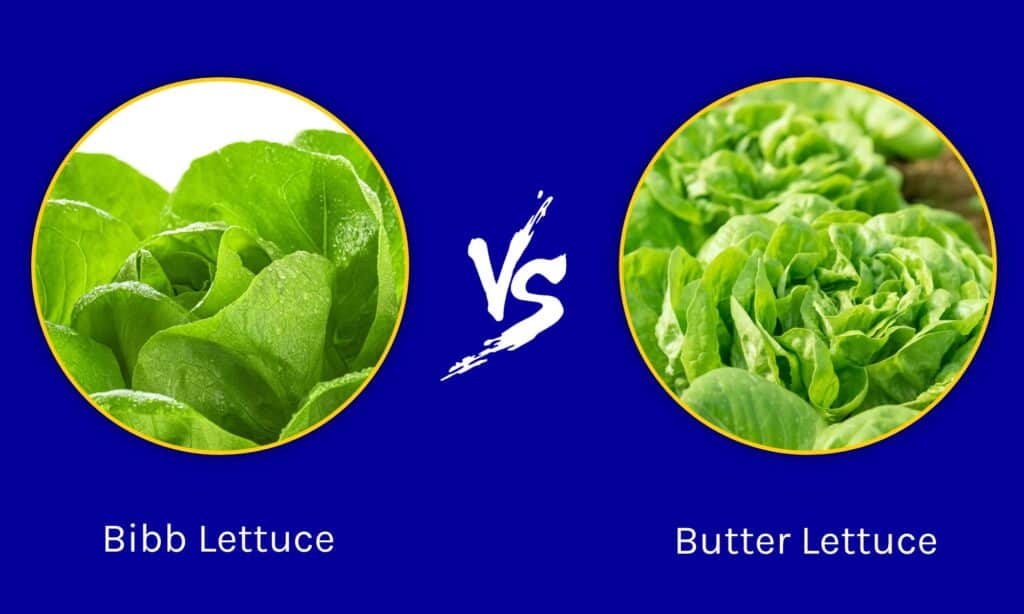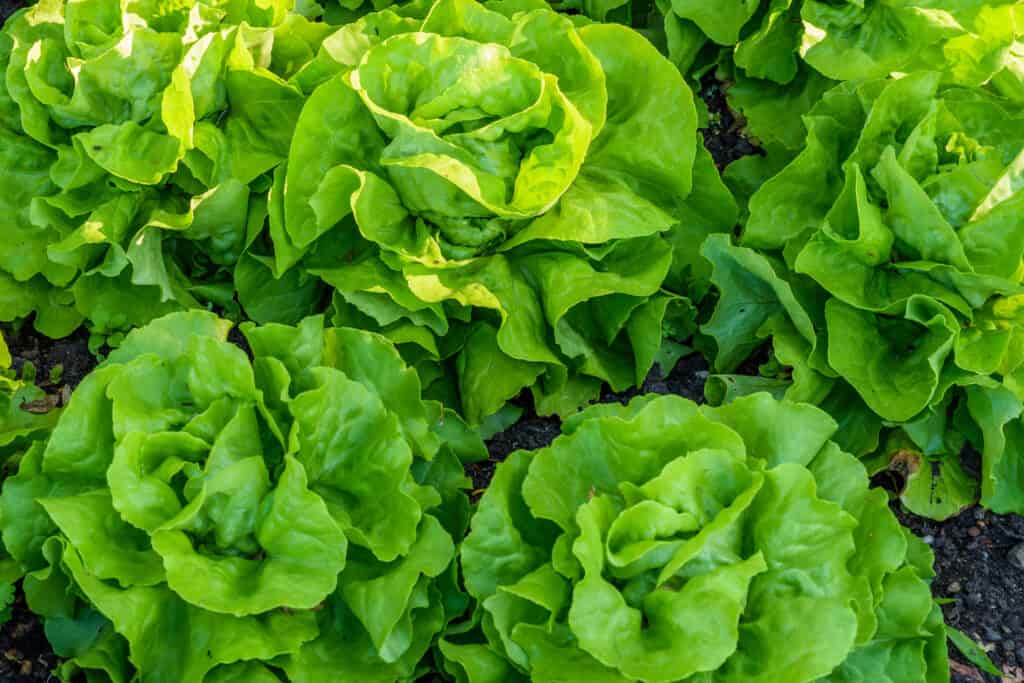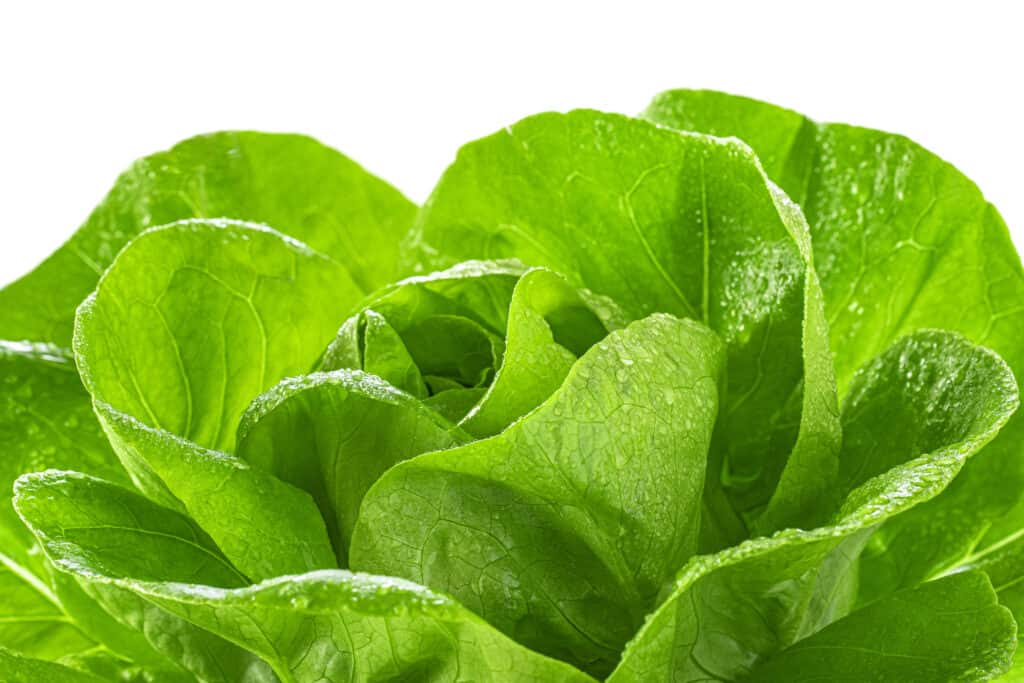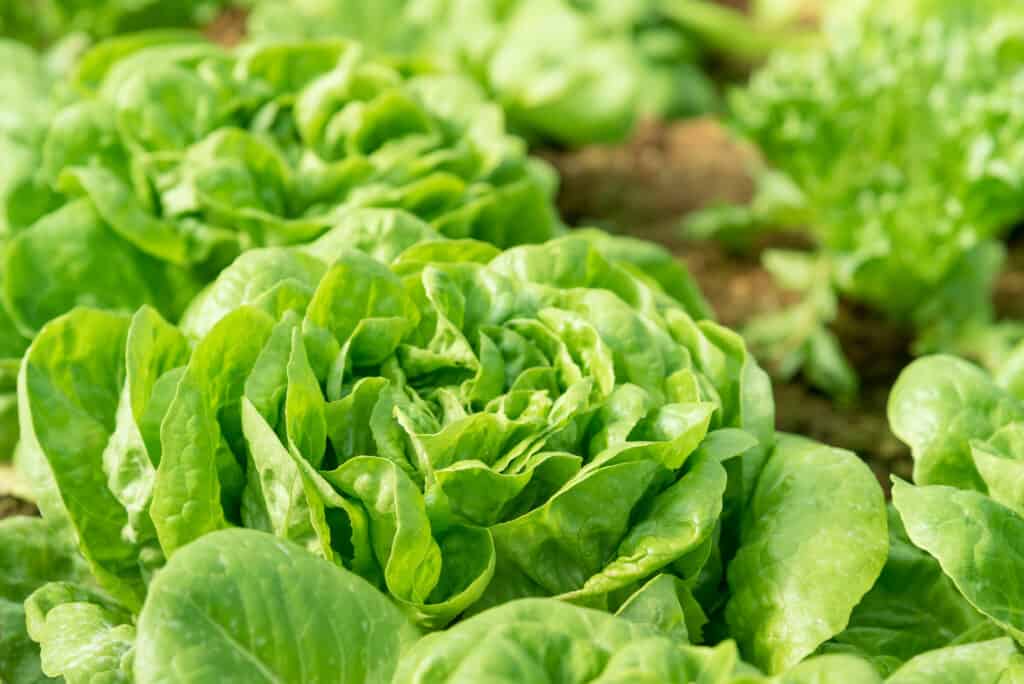Some people believe Bibb lettuce is a very different variety from butter lettuce. However, Bibb lettuce is nothing more than a slight variation of the latter. In fact, they are pretty similar in taste and how they’re used, with the most significant differences being Bibb lettuce’s size and price.
Now that you know this, we’ll compare these two healthy types of lettuce and tell you why you’d do well in including either in your diet. We’ll also talk about the origins of the term “Bibb” and show you delicious and nutritious foods that pair well with these varieties. Let’s get started!
Comparing Bibb Lettuce vs. Butter Lettuce

| Bibb Lettuce | Butter Lettuce | |
|---|---|---|
| Classification | Lactuca sativa ‘Bibb’ | Lactuca sativa cv. Capitata |
| Origin | Developed from Boston lettuce in Kentucky, U.S., in the mid-19th century | Originated in the Mediterranean; the first documentation of cultivation began in Ancient Egypt, 3000 BC |
| Description | A smaller, sweeter version of butter lettuce; small, round head of dark green color with light green leaves of buttery texture; about the size of a fist | A variety of green lettuce exhibiting tender leaves and green or reddish-purple hue; small, round heads; very mild, butterfly flavor; grows about 12 inches tall and w.ide |
| Uses | Used for its tenderness and size in wraps, salads, and side dishes; it can be eaten raw or cooked with other ingredients like other types of lettuce. | Frequently used raw to wrap ingredients or as a crunchy component in salads and hamburgers; it can be cooked and fried alongside oil and spices for a healthy side dish. |
| Nutrition | High in vitamins A and C, calcium, potassium, and iron; low-calorie and low-carb food | Brims with vitamins A, C, K, calcium, and iron; low-calorie and low-carb food |
Key Differences Between Bibb Lettuce vs. Butter Lettuce
Butter lettuce is sometimes mistakenly called “Bibb,” even though there are a few — although slight — differences between the two varieties.
One of the most prominent ones is Bibb lettuce’s size, which is about half as big as butter lettuce. Bibb lettuce is also typically more expensive than its counterpart, as it is hard to transport because of how easily it spoils and bruises.
We’ll delve into other key differences further below!
Bibb Lettuce vs. Butter Lettuce: Origin

Butter lettuce’s first documentation of cultivation began in Ancient Egypt.
©iStock.com/Conny Pokorny
Butter lettuce’s first documentation of cultivation began in Ancient Egypt, almost 5000 years ago, though it was probably grown and used in the Middle East far before that. It is one of about half a dozen lettuce varieties belonging to the Asteraceae family of daisies.
Bibb lettuce was developed sometime after 1865 from Boston lettuce — a variety of butter lettuce — by John Bibb, a Kentuckian war veteran and lawyer. First called “limestone lettuce,” it was eventually named Bibb lettuce in his honor. The green wasn’t commercially available until a century later, and it took many more decades to become popular. Today, Bibb lettuce is one of the most sought-after varieties of butter lettuce, the other being Boston lettuce.
Bibb Lettuce vs. Butter Lettuce: Growth and Harvesting
Butter lettuce prefers cool weather and will grow best in temperate climates. Farmers typically grow it across the U.S. during spring and fall in full sun. It grows best in loose, well-drained, and cool soils with pH levels somewhere between 6.2 and 6.8. Butter lettuce takes about 65 days to fully mature, though you can pick grown leaves during the growing cycle after about 30 days from germination.
Bibb lettuce is available in various places throughout the U.S. and Western Europe, as it efficiently grows in cool, somewhat moist climates. While it grows best in full sun, gardeners often grow it in temperature-controlled greenhouses. Relative to most other types of lettuce, Bibb lettuce is more tolerant of heat, though it is best planted during spring, away from the summer sun. Heads grown naturally are typically ready for harvest after about 60 days. Still, leaves can be picked throughout the growing cycle.
Bibb Lettuce vs. Butter Lettuce: Nutrition and Benefits

Bibb lettuce is tremendously low in calories and contains negligible amounts of fat.
©iStock.com/ElcovaLana
Butter lettuce is full of important vitamins, particularly A, C, and K, the latter helping immensely in the production of proteins needed for blood clotting and bone building. It is a low-carb, low-fat, low-calorie food rich in iron and antioxidants. Eating it regularly will reduce the risk of developing diseases and help you maintain healthy bones and skin.
Like butter lettuce, Bibb lettuce is tremendously low in calories and contains negligible amounts of fat. It is also impressively high in vitamins A and C, as well as calcium, iron, and potassium, making it a solid, nutritious addition to your weight-loss diet. This variety of lettuce will provide a green, buttery touch to your foods that won’t be fattening or harmful. Plus, it has a relatively high amount of fiber, which will benefit your digestive health.
Bibb Lettuce vs. Butter Lettuce: Flavor
Butter lettuce doesn’t have a noticeable buttery flavor, but it does have a silky-soft texture that feels as if it melts in your mouth. There is also a slight hint of sweetness which pairs well with cheeses and strong flavors like chutney.
Bibb lettuce has a similar taste to butter lettuce, though slightly sweeter and more buttery. Most of its flavor is concentrated in the leaf stems, which some cooks unknowingly remove, often missing what makes this particular variety popular in high-end restaurants.
Bibb Lettuce vs. Butter Lettuce: Uses

Butter lettuce can be eaten raw, though many prefer cooking it alongside spices and other greens.
©iStock.com/fotolism_thai
Butter lettuce is most often used in salads and included in hamburgers and other kinds of food like soups and wraps. It can be eaten raw, though many prefer cooking it alongside spices and other greens. In addition, it pairs well with meats and creamy, savory dressings.
Some of Bibb lettuce’s most popular pairings in recipes include fish — especially tuna and salmon — apple, and mandarin orange. The leaves are typically used as a base for salads or chopped and mixed with other greens. Like butter lettuce, whole leaves are often used on sandwiches, particularly those with intense, contrasting flavors like mustard, which pair well with Bibb’s buttery aftertaste.
Up Next:
- 19 Vegetables to Plant in September
- Cabbage vs. Lettuce: 5 Key Differences
- Iceberg Lettuce vs. Cabbage: 5 Key Differences
- Can Dogs Eat Lettuce? It Depends on How It’s Been Prepared
The photo featured at the top of this post is © iStock.com/Conny Pokorny
Sources
- The Spruce Eats, Available here: https://www.thespruceeats.com/what-is-butter-lettuce-4773670
- Finedining Lovers, Available here: https://www.finedininglovers.com/article/what-is-butter-lettuce
- Specialty Produce, Available here: https://specialtyproduce.com/produce/Boston_Bibb_Lettuce_529.php
- The Spruce Eats, Available here: https://www.thespruceeats.com/what-is-bibb-lettuce-and-how-to-use-it-4782115
- Gardening Know How, Available here: https://www.gardeningknowhow.com/edible/vegetables/lettuce/growing-bibb-lettuce.htm
- Kentucky History, Available here: https://explorekyhistory.ky.gov/items/show/47
Thank you for reading! Have some feedback for us? Contact the AZ Animals editorial team.






